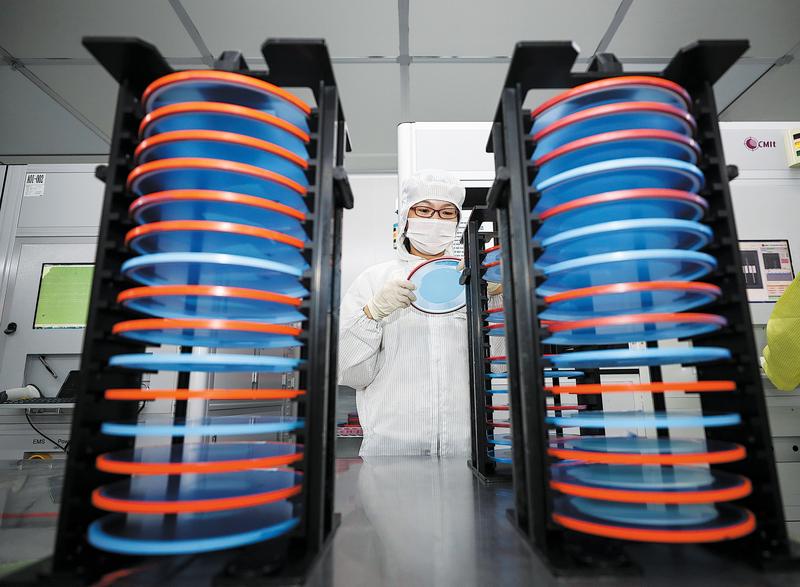 A staff member of Huaian Aucksun Optoelectronics Technology Ltd works at a chip production line on June 16. China has intensified efforts to develop chips at home so as to reduce reliance on the foreign semiconductor industry. (ZHAO QIRUI / FOR CHINA DAILY)
A staff member of Huaian Aucksun Optoelectronics Technology Ltd works at a chip production line on June 16. China has intensified efforts to develop chips at home so as to reduce reliance on the foreign semiconductor industry. (ZHAO QIRUI / FOR CHINA DAILY)
This year is likely to prove fruitful for Dou Qiang. The president of Tianjin Phytium Information Technology Co Ltd, a Chinese manufacturer of server chips or integrated circuits (ICs), has been busy answering incessant phone calls from prospective customers desperate to receive supplies of chips.
“Demand for chips manufactured by Chinese companies has been very intense these days. The number of buy orders had already hit a record high at the beginning of last year,” Dou said.
Demand, he reiterated, has been “far more than what was expected”.
Dou noted that the company’s best-selling chip was originally estimated to reach 1 million units in shipment by the end of last year, but that figure had already been reached by August.
His optimism knows no bounds now as the Chinese government has intensified efforts to develop chips at home so as to reduce reliance on the foreign semiconductor industry.
That move toward self-reliance comes amid Sino-US trade frictions, which drove unprecedented levels of enthusiasm as well as capital of Chinese entrepreneurs into the domestic chip industry.
Last year, investors poured more than 200 billion yuan (US$30.9 billion) — much higher than the 70 billion yuan or more seen in 2019 — into the country’s semiconductor industry. Venture capitalists, private equity firms, and IPOs of startups were among the sources of funding.
The annual tone-setting Central Economic Work Conference in December highlighted the importance of “technological innovations” to solve major problems that restrict the nation’s economic development.
The conference said China will ensure better implementation of key projects targeting breakthroughs in crucial technologies and solutions to bottleneck problems while encouraging businesses to focus on their areas of strength and forge new cutting-edge technologies.
Zhang Yansheng, chief researcher of the China Center for International Economic Exchanges, said: “It’s a clear sign that China, starting from this year, will take the building of self-reliant technological prowess as its fundamental guiding principle.”
The nature of the world’s leading economies has changed significantly. An industrial and supply chain that is shorter, more flexible, and more resilient will better meet the new economic pattern, Zhang said.
Jia Kang, chief economist of the think tank China Academy of New Supply-Side Economics, said that another focus of the conference was on the “bottleneck problems”, which refer to technologies at the forefront of innovation and futuristic vision, such as high-end chips.
“Bottleneck problems are where China lagged behind and may be restricted by other economies. It’s an area wherein China must make breakthroughs over the next five years and beyond,” Jia said.
His remarks come on the heels of the country’s latest tax incentive policies for the IC industry in December. The new policy, launched by the Ministry of Finance and three other ministries, stated that qualifying IC companies or projects that have been in operation for more than 15 years and that make 28-nanometer or smaller advanced chips will be exempt from corporate income taxes for up to 10 years.
 A visitor inspects the Loongson 3 series processors at the World Internet Conference in Wuzhen, Zhejiang province, on Nov 22. (ZHAI HUIYONG / FOR CHINA DAILY)
A visitor inspects the Loongson 3 series processors at the World Internet Conference in Wuzhen, Zhejiang province, on Nov 22. (ZHAI HUIYONG / FOR CHINA DAILY)
Companies producing 65-nanometer to 28-nanometer chips will get five years of tax exemption and a 50 percent discount on the corporate tax rate for the subsequent five years. For such chip manufacturers, preferential treatment begins from the first profitable year.
“The fresh policies will greatly reduce the tax burden on semiconductor enterprises and encourage them to invest more into research and development and to upgrade integrated circuits,” said Chen Ji, head of the industry economy research institute at the Capital University of Economics and Business.
Xu Tao, chief electronics analyst at CITIC Securities, said that for Semiconductor Manufacturing North China (Beijing) Corp, a subsidiary of chipmaker Semiconductor Manufacturing International Corp, the new incentives will help the company save about US$10 million each year in taxes.
“These policies will drive companies to strive for more advanced production lines and boost the competitiveness of the nation’s semiconductor industry on the global stage,” Xu said.
According to a report from Everbright Securities, the total income tax of A-share semiconductor companies hit 2.57 billion yuan in 2019. These companies reported a total profit of 20.96 billion yuan.
“As the US government moves to impose export controls on Chinese technology firms, companies in the tech sector, including mobile phones, 5G and communications, have begun to feel an urgent need to work with domestic semiconductor companies,” said Huang Qing, China managing director of Walden International, a US venture capital company focused on cross-border investments.
“By serving such tech giants in the ecosystem, Chinese chip companies will have an unprecedented opportunity to grow into global players,” Huang said.
The United States government put Huawei on the so-called Entity List in May 2019 and said US firms were required to obtain a license before exporting domestically produced chips and software to the company.
In May last year, Washington expanded these rules by requiring contract chip producers anywhere in the world that use US semiconductor equipment and technology to obtain its approval before producing chips designed by Huawei’s subsidiary HiSilicon.
Data from the China Semiconductor Industry Association IC Design Branch suggested that the total sales volume of China’s IC design industry is expected to grow about 24 percent year-on-year to reach nearly 382 billion yuan by the end of 2020, accounting for nearly 13 percent of the total sales revenue in the global IC design market. Full-year industry data for 2020 is yet to be compiled and confirmed.
Buoyed by the country’s momentum, China’s top chipmaker SMIC saw its revenue rise by nearly 33 percent on a yearly basis to a record US$1.08 billion during the third quarter of last year, after debuting on the technology-focused STAR Market of the Shanghai Stock Exchange in July.
Liang Mengsong, then co-CEO of SMIC, said earlier that the company’s second-generation technology N+1 is advancing steadily and is currently undergoing product verifications from customers.
Compared with the existing 14-nanometer process, N+1 manufacturing technology can increase a chip’s performance by 20 percent and cut its power consumption by 57 percent, industry insiders said.
“The N+1 has entered a small-volume market and the applications are mainly for high-performance computing,” Liang said. “SMIC is also cooperating with domestic and overseas customers on more than 10 advanced process tape-out projects, including 14-nanometer process and more advanced technologies.”
Founded in 2000, SMIC has successfully mass-produced a smartphone processor for Huawei Technologies Co with its 14-nanometer manufacturing process, marking a breakthrough in China’s efforts to boost its chip-making industry.
The 14-nanometer process is SMIC’s most advanced process available as of now, and can be used in smartphones, tablets, set-top boxes, artificial intelligence, radio frequency and other applications.
Ding Wenwu, president of China Integrated Circuit Industry Investment Fund Co Ltd, said that although the country witnessed rising flow of money into the chip design segment over the past decade, more efforts are needed in the fields of chip materials, equipment and manufacturing.
“Chip design has a lower technological threshold and quick investment returns. But chip materials, equipment and manufacturing are where China lags behind compared with developed countries including the US,” Ding said.
Wei Shaojun, professor from the Institute of Microelectronics at Tsinghua University in Beijing, said that in the high-end chips segment in particular, the market share of domestic chips in computer systems, general electronic systems communication equipment, storage devices, display and video systems, still remains small in the country.
“China is also expected to adjust the structure of its chip industry. Foreign countries have integrated device manufacturers, which integrate multiple steps from chip design, manufacturing, packaging, testing to sales,” Wei said.
“With an integrated circle, costs are suppressed to the lowest level, which further lowers the price and maintains its market advantage.”


